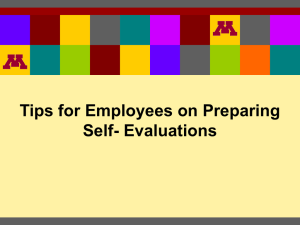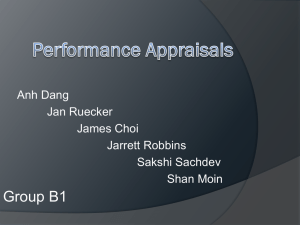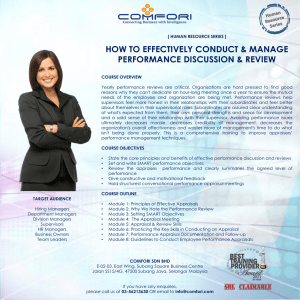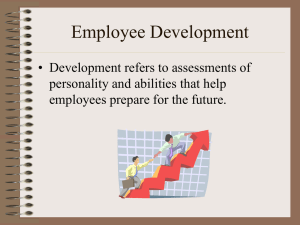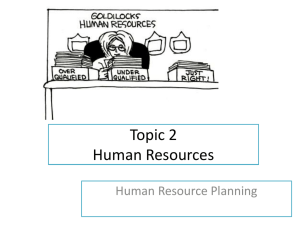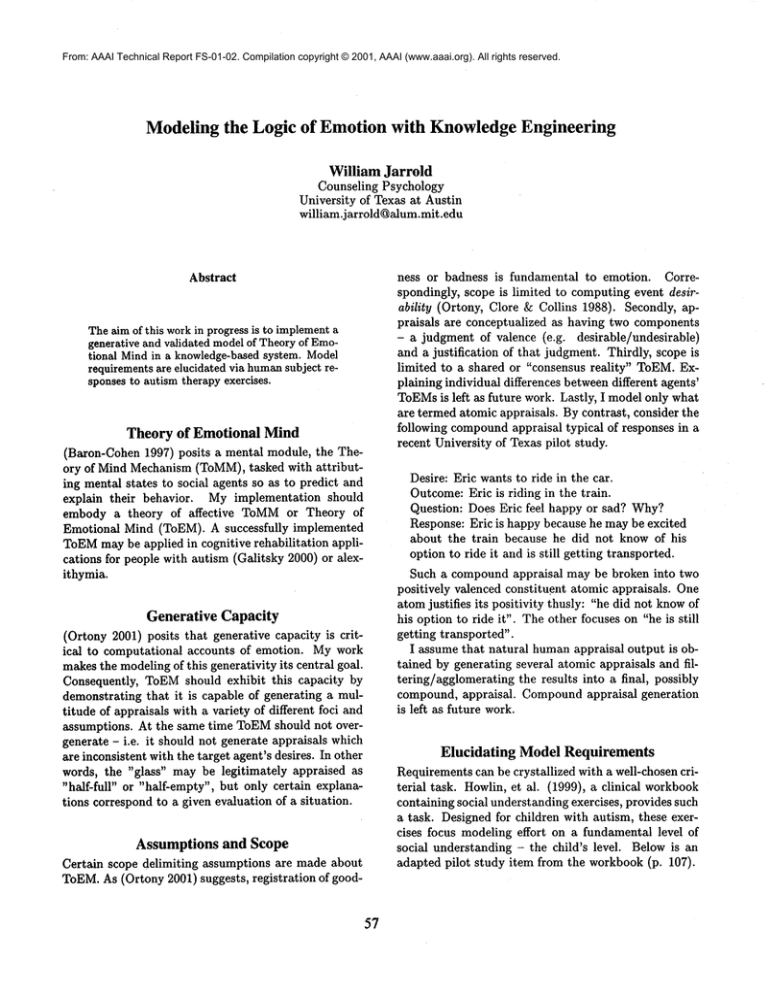
From: AAAI Technical Report FS-01-02. Compilation copyright © 2001, AAAI (www.aaai.org). All rights reserved.
Modeling the Logic of Emotion with KnowledgeEngineering
William Jarrold
Counseling Psychology
University of Texas at Austin
william.j arrold@alum.mit.edu
Abstract
The aim of this workin progress is to implementa
generative and validated modelof Theoryof Emotional Mindin a knowledge-basedsystem. Model
requirements are elucidated via humansubject responses to autism therapy exercises.
Theory of Emotional Mind
(Baron-Cohen 1997) posits a mental module, the Theory of Mind ]Mechanism (ToMM),tasked with attributing mental states to social agents so as to predict and
explain their behavior. My implementation should
embody a theory of affective
ToMMor Theory of
Emotional Mind (ToE]M). A successfully implemented
ToEMmay be applied in cognitive rehabilitation applications for people with autism (Gaiitsky 2000) or alexithymia.
Generative Capacity
(Ortony 2001) posits that generative capacity is critical to computational accounts of emotion. My work
makesthe modelingof this generativity its central goal.
Consequently, ToEMshould exhibit this capacity by
demonstrating that it is capable of generating a multitude of appraisals with a variety of different foci and
assumptions. At the same time ToEMshould not overgenerate - i.e. it should not generate appraisals which
are inconsistent with the target agent’s desires. In other
words, the "glass" may be legitimately appraised as
"half-full" or "half-empty’, but only certain explanations correspond to a given evaluation of a situation.
Assumptions and Scope
Certain scope delimiting assumptions are made about
ToEM.As (Ortony 2001) suggests, registration of good-
57
ness or badness is fundamental to emotion. Correspondingly, scope is limited to computing event desirability (Ortony, Clore & Collins 1988). Secondly, appraisals are conceptualized as having two components
- a judgment of valence (e.g. desirable/undesirable)
and a justification of that judgment. Thirdly, scope is
limited to a shared or "consensus reality" ToEM.Explaining individual differences between different agents’
ToEMsis left as future work. Lastly, I model only what
are termed atomic appraisals. By contrast, consider the
following compoundappraisal typical of responses in a
recent University of Texas pilot study.
Desire: Eric wants to ride in the car.
Outcome:Eric is riding in the train.
Question: Does Eric feel happy or sad? Why?
Response: Eric is happy because he may be excited
about the train because he did not know of his
option to ride it and is still getting transported.
Such a compound appraisal may be broken into two
positively valenced constituent atomic appraisals. One
atom justifies its positivity thusly: "he did not knowof
his option to ride it". The other focuses on "he is still
getting transported".
I assume that natural humanappraisal output is obtained by generating several atomic appraisals and filtering/agglomerating the results into a final, possibly
compound, appraisal. Compoundappraisal generation
is left as future work.
Elucidating Model Requirements
Requirements can be crystallized with a well-chosen criterial task. Howlin, et al. (1999), a clinical workbook
containing social understanding exercises, provides such
a task. Designed for children with autism, these exercises focus modeling effort on a fundamental level of
social understanding - the child’s level. Below is an
adapted pilot study item from the workbook (p. 107).
Example A
Desire: Tracy wants to eat a banana.
Outcome: Mummygives Tracy an apple.
Question: Does Tracy feel happy or sad? Why?
¯ The ToEMimplementation should generate all and
only the legitimate atomic appraisals for situations.
Pilot data on items like the aboveillustrates appraisal
generativity - despite scenario simplicity, a wide variety
of responses were btalned. The criterial task is to generate a set of legitimate appraisals similar to the union of
subjects’ atomic appraisals. By modeling human data
from such a task we reduce the chance that the final
system will exhibit biases deriving from the modeler’s
favorite theory of emotion or other idiosyncrasies.
KnowledgeEngineering
This model can be constructed in a knowledge based
2. This sketch exemplisystem such as Cyc1 or KM
fies how ToEMcomponents (bold) interact with background knowledge to exhibit the sort of generativity
found in data described above. Take Example A. An
appraisal type known as Inferable Goal Failure would
produce a negative evaluation justified by background
knowledge that apples are different from bananas. Additionally, pilot study data showsthat several positively
valenced Goal Substitution appraisals are generated for
cases like Example A. Drawing on taxonomic knowledge that apples are a kind of food, Goal Substitution
(Schank & Abelson 1977) construes the situation positively by assuming that what Tracy really wanted was
food. Alternatively, knowledge that both bananas and
apples are kinds of fruit can be used to generate another
positive appraisal: "at least Tracy got fruit". Anadditional positive appraisal of this type can be generated
using background knowledge to assume that Tracy has
a tacit goal to receive attention from her parents. Appraisals based on comparison to counterfactuals such
as "Tracy is happy - at least she wasn’t given liver!"
can be generated via Downward or Upward Comparison (Ben-Ze’ev 2000). As described above, background
knowledge about object properties, taxonomic relationships and typical humangoals applies in specific ways
to particular examples of ToEMontology components.
Evaluation
The first hypothesis may be tested by asking subjects
to distinguish legitimate from illegitimate appraisals.
The second may be tested in two parts - the "all" part
and the "only" part. The "only" part can be measured
by the extent to which subjects find model generated
appraisals sensible. The "all" part can be evaluated by
the extent to which for every sampled humanappraisal
there is a model generated appraisal judged similar to
it. Computational Ablation (Porter, Bareiss & Holte
1990) can be used to verify that the model is functioning as hypothesized. The basic idea is to compare performance between the full model implementation and
an implementation which has been ablated or damaged
in a specific way. If the modelis correctly understood,
ablated implementations should behave as predicted.
References
Baron-Cohen, S. (1997) "How to build a baby that
can read minds" chapter in The Maladapted Mind,
Baron-Cohen, S. ed, Psychology Press, East Sussex UK.
Ben-Ze’ev, Aaron. (2000) The Subtlety of Emotions
MIT Press, Cambridge Massachusetts.
Galitsky, Boris (2000) "Question-answering system
for teaching autistic children to reason about mental
states" DIMACSTechnical Report 2000-25 September
2000.
Howlin P., Baron-Cohen S., Hadwin J. (1999) Teaching children with autism to mind-read : a practical
guide for teachers and parents Chichester ; NewYork :
J. Wiley & Sons.
Ortony, Clore and Collins (1988) The Cognitive
Structure of Emotion Cambridge University Press,
Cambridge England.
Ortony, A. (2001). to appear in R. Trappl &
Petta (eds), Emotion in Humans and Artifacts,
MIT
Press, Cambridge, MA2001.
Havingintroduced the issues, a more precise statement
of the claims and howto evaluate them is possible.
Porter B. W., Bareiss E. R., and Holte R. C.
(1990) "Concept learning and heuristic classification
weak-theory domains." Artificial Intelligence, 45(1-2).
* Subjects should be nearly unanimous in their judgments of appraisal legitimacy.
Schank, R., Abelson, R. (1977) Scripts Plans Goals
and Understanding John Wiley & Sons, NewYork.
i http://www.cyc.com
2http:llwww.cs.utexas.eduluserslmfkblRKF/km.html
58

